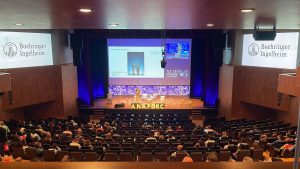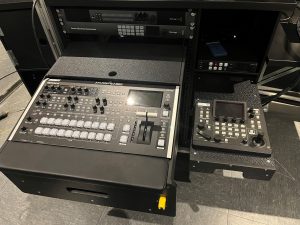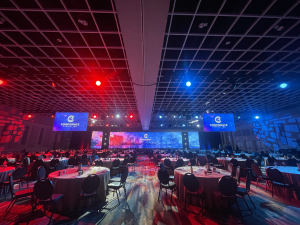- Roland has produced Pro A/V products for business and commercial use for decades.
- The Roland T-bar is a durable, dynamic feature of Roland switchers.
- Engineer Masayuki Hirase was at the forefront of the development process for the T-bar technology, drawing influences from many sources.
Over the last two and a half decades, Roland video products have steadily gained industry prominence. From livestreaming to massive events, professionals worldwide rely on Roland switchers. In fact, the company has produced video products for almost half its history, with 2023 marking the 25th anniversary of the first Roland switcher. Masayuki Hirase, the developer of Roland’s first hardware video switcher, discusses the story behind the company’s unique T-bar technology.
The Greatest Challenge
Roland created its first switcher 25 years ago. Would you explain the development of the T-bar?
Hirase: Developing the T-bar was the biggest hurdle in making the V-5. Roland’s synthesizers have levers like pitch benders, so we already had the technology to design them. However, we did not have the technology to make a controller like a switcher’s T-bar. So, at that time, while making a product called V-5, we ran a T-bar development project in the background.
First, if you unravel the T-bar, various patents come out from manufacturers that make switchers for broadcasters. It was necessary to avoid these patents when designing. Reducing costs required simple construction, and we also had to consider durability.
Developing the T-bar was the biggest hurdle in making the V-5. Roland’s synthesizers have levers like pitch benders, so we already had the technology to design them.
Masayuke Hirase
Synthspiration
So, you weren’t using a commercially available general-purpose T-bar?
Hirase: Only one manufacturer sold it on the market, but it was costly. So we had to make it ourselves to reduce production costs. After much trial and error, we based the best one on the structure of the pitch bender on a synthesizer. A pitch bender is one of the most durable parts of a synthesizer.
At the time, there was no idea of taking production switchers outside and using them for live events. However, I aimed to make them usable in live shows like VJs. As a result, I couldn’t give up on the durability of the pitch bender.
Tension Testing
When using it on VJ or live performance, the operator’s tension rises, sometimes moving violently.
Hirase: That’s right. The mechanism of the pitch bender was a great reference with high durability for the T-bar. Simply put, we designed it so no force gets applied directly to the volume sensor. Instead of the metal fittings directly turning the shaft, we structured it to turn it through an extra gear.
This design ensures intense movement does not affect the sensor or the board. Once we made the prototype, we decided that we had to measure its durability. There is a limit to the ability of humans to keep running during testing, so we built a test machine.
I would stop in the middle of the test and check that the resistance value of the T-bar sensor didn’t change. Then, if there were no problems, I'd resume operation. After repeating this task exceeding millions of times, we completed the testing.
Masayuke Hirase
So, a testing machine moved the T-bar back and forth?
Hirase: Yes. I made a pneumatic piston machine with a T-bar between them. But I moved it so quickly that the machine broke down. Still, the T-bar was OK.
Since pneumatic piston machines are not durable, we made a new machine. It had a crank structure like a locomotive wheel operated by an electric motor. I placed it on a counter and kept it running 24 hours a day for about three months.
That’s tens of thousands of times, correct?
Hirase: It was more than a million. I would stop in the middle of the test and check that the resistance value of the T-bar sensor didn’t change. Then, if there were no problems, I’d resume operation. After repeating this task exceeding millions of times, we completed the testing. As a result, the T-bar mechanism was able to withstand intense usage.

A Robust Culture
Is this T-bar used on the current V-series?
Hirase: The basic structure is the same. The video has changed to HD or 4K, the width has become wider, and the resolution has increased, so we have updated the circuit. But the basic hardware has stayed the same.
Roland video products are very sturdy, beyond just T-bars. Is this related to the company’s history as an instrument manufacturer?
Hirase: Roland is a musical instrument maker. We have been developing and manufacturing products for many years. These include synthesizers and drums, where beating and playing hard is natural. Know-how and design ideas that can withstand rough handling get shared among all departments. Perhaps the company has a culture, a “Roland quality standard.”
I look at Pro A/V quality assurance and durability standards in the same way as synthesizers. The so-called drop tests are all the same. Robustness is one of the characteristics of all our products. The current standards for Roland’s Pro A/V products are even more up-to-date than they were at the time. Over 25 years, users have broken the product in a way we couldn’t imagine, and that report has allowed us to upgrade our standards.




